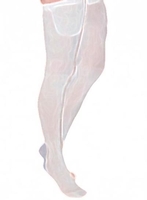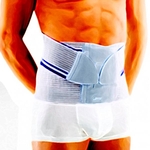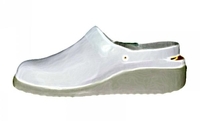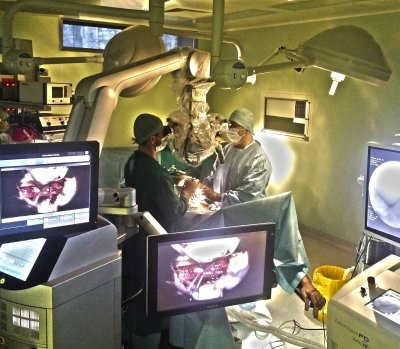Spine surgery, part 2: Preparation for surgery
So, the decision is made: pain is so intense, that you are ready to get rid of it. You are ready for operation.What should you know about the operation??
First of all, after your doctor found indications for surgery, he/she begins to search for contraindications. You are getting blood tests, X-rays, ECG, so your doctor can be sure there will be no problems with general anesthesia because of other illnesses. D-dimer test and Doppler ultrasound for lower limbs are crucial before surgery. Your doctor should know if there is any thrombosis, and make all necessary preparations to prevent thromboembolic complications. In case you have no contraindications for operation, your doctor will proceed with preparation for surgery.

Compression stockings. Compression stockings are critical for the prevention of thromboembolic complications in orthopedic surgery. You can use elastic bandage (2.5-3.0 m are enough for one limb) or the special compression stockings. Compression stockings are preferable, since they provide more uniform and reliable compression, and your doctor can advise you how to use them properly. As a rule, you should put on compression stockings in the morning on the day of surgery, and then wear them for seven days after the operation. You can take off compression stockings during the day just for a short time for hygienic purposes. Compression stockings are selected before surgery to the size of your lower limbs.
 After surgery you will also need a corset. It will support your spine for a several months after the operation. Your corset should be convenient and functional. If the corset is inconvenient, it brings suff ering, and instead of the aid you could have troubles with putting the corset on. Some patients after the week of inconvenience put the corset aside and disrupt the specified regime, thus delaying recovery. Therefore you should select the corset before the operation (as yet there is no incision, no bandage, and it is possible to choose the suitable model from the large assortment).
After surgery you will also need a corset. It will support your spine for a several months after the operation. Your corset should be convenient and functional. If the corset is inconvenient, it brings suff ering, and instead of the aid you could have troubles with putting the corset on. Some patients after the week of inconvenience put the corset aside and disrupt the specified regime, thus delaying recovery. Therefore you should select the corset before the operation (as yet there is no incision, no bandage, and it is possible to choose the suitable model from the large assortment). 
Shoes are also very important for early ambulation after surgery. We recommend orthopedic footwear with the broad nose, the longitudinal instep, and the closed foot bearing. This footwear helps to rise from the bed correctly and keep a good balance during the first days after the operation, go through the early ambulation without the risk of falling, which is very probable with the sandals of flip-flops. You can use special orthopedic shoes or comfortable shoes for adults with flat feet. You can also use moccasins or light training shoes without lacing.
After all these preparations your doctor will assign the date of operation. Anaesthesiologist examines patient the day before surgery and explains the procedure. In the evening before the surgery, the patient gets light supper, enema, and a sleeping pill to have a good night sleep and not to be nervous. In the morning at 7:00 am patient puts on compression stockings. Starting from 9:00 am patients are scheduled for surgery. In operating room after quick manipulations – installation of an intravenous catheter, ECG electrodes, and pulse oximeter – patient gets an injection of anesthetics and goes to sleep. As soon as the anesthesia starts to work and patient feels no pain, anesthesiologist gives permission to continue the operation. Surgeon and his assistants turn the patient on the operating table in convenient position, laying soft cushions under the breast, thighs, where bones are close to the skin to avoid pressure sores. The surgeon makes preliminary marking (to decrease the length of the incision), and operation begins.
During the operation, the anesthesiologist monitors patients pressure, pulse, respiration, and continuously injects medicines so that the patient would not feel pain.

At the end of the operation, the patient wakes up. After contemporary anesthesia, the patient wakes up in 5-10 minutes. After the restoration of consciousness and respiration, the patient is transferred to the ward and stays under monitoring for another 2 hours.
After operation patient has drainage. It is a small tube, which remains in the wound after the operation. It evacuates serosanguinous fluid that accumulates in the wound from capillaries. It's important to drain this fluid from the wound to promote better healing and decrease the risk of complications. Drainage stays for 1 or 2 days after surgery and then is removed.
The patient can stand up on the second or third day after the operation. First just raising on the bed, then, with the support and under the control of instructor – standing near the bed. At each session, instructor increases the level of physical exertion, and in 3-4 days after operation patients already walk along the corridor. At the moment of suture removal on Day 7-10, all patients are active and independent. The only limitation still is a limited time in sitting position. We do not forbid patients to sit entirely - they can sit down in the toilet and on the regular chair. However, we do not recommend sitting in the deep armchair or driving immediately after the operation. We advise patients to do 3-4 the week's rehabilitation first to strengthen body muscles and finish with an orthopedic corset. The patient can start loading his/her back in 4-6 months after the operation. For this period we recommend patients to abstain from active sports, such as skiing, skating, football, sky jumping, which are associated with high risk of back trauma. In 4-6 months of regular training for back muscles (repeated courses of rehabilitative treatment are advised, especially to athletes), the patient can use his/her back in full, even play football, fly the aircraft, or go into space.
To prevent spine diseases and disc herniation, just follow these simple rules: do gymnastics for your back every day, follow the diet, control your weight, keep the good physical shape, avoid injuries and excessive loads on your back.
Stay healthy!


